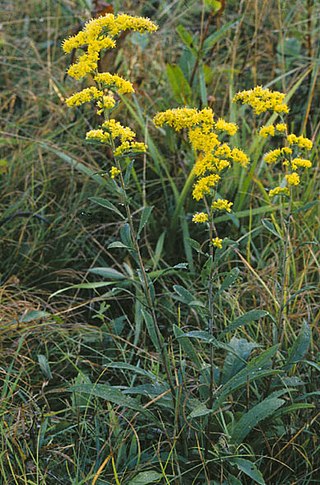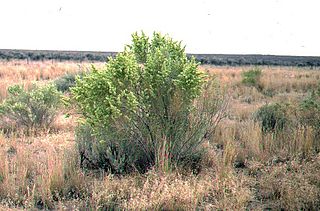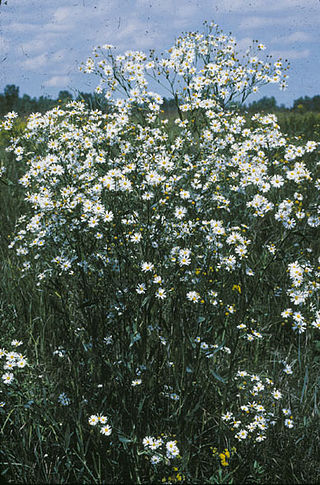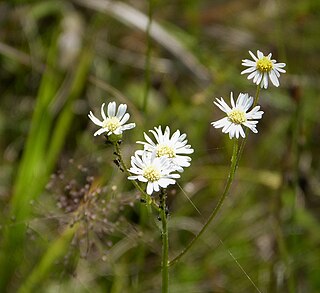Insects
- † Boltonia robusta , a monotypic genus of extinct orthopterans
- Bazboltonia , a genus of ants formerly known as Boltonia
Boltonia may refer to one of several organisms.

Goldenrod is a common name for many species of flowering plants in the sunflower family, Asteraceae, commonly in reference to the genus Solidago.
Alicia may refer to:

Saltbush is a vernacular plant name that most often refers to Atriplex, a genus of about 250 plants distributed worldwide from subtropical to subarctic regions. Atriplex species are native to Australia, North and South America, and Eurasia. Many Atriplex species are halophytes and are adapted to dry environments with salty soils.

Boltonia asteroides, the white doll's daisy, false chamomile, or false aster, is a species of plant native to the United States and Canada. It is found primarily in the Mississippi Valley and Great Plains from Saskatchewan south to Texas and Florida, with isolated populations in the eastern United States. Reports of the species in New England, New York, and the Pacific Northwest appear to be introductions.

Boltonia diffusa, the smallhead doll's daisy, is a North American species of plants in the family Asteraceae. It is native to the United States, primarily the states along the Gulf of Mexico from Texas to Florida plus the lower Mississippi Valley from Louisiana to Illinois. There additional populations in the eastern United States as far north as Virginia.

Astereae is a tribe of plants in the family Asteraceae that includes annuals, biennials, perennials, subshrubs, shrubs, and trees. They are found primarily in temperate regions of the world. Plants within the tribe are present nearly worldwide divided into over 250 genera and more than 3,100 species, making it the second-largest tribe in the family behind Senecioneae.
Live Forever or Liveforever may refer to:

Boltonia is a genus of plants in the family Asteraceae native primarily to North America with one species in eastern Asia.
Nasturtium may refer to:
Turricula, turret in Latin, may refer to:

Boltonia decurrens is a rare species of flowering plant in the family Asteraceae known by the common names decurrent false aster and claspingleaf doll's daisy. It is native to the floodplains along the Illinois and Mississippi Rivers in the United States, where the habitat has been drastically altered, leading to its decline. The plant was once distributed across 400 kilometers of riverside forest from LaSalle, Illinois, to St. Louis, Missouri. As the rivers and riparian habitat alongside them have been developed, the plant's distribution has been fragmented into 40 to 43 separate populations. At one point it was thought to have been extirpated from Missouri, but a few populations have been located near St. Louis since the mid-1980s. Despite having declined over time, several populations of the plant contain many thousands of individuals. Populations vary depending on the amount and duration of flooding that occurs in the area each year. The plant is a federally listed threatened species.
Plantain may refer to:
Boltonia apalachicolensis, common name Apalachicola doll's-daisy, is a North American species of plants in the family Asteraceae. It is found in the "panhandle" region of northwestern Florida, and has been found in south Louisiana, and Mississippi in the United States.

Boltonia lautureana is an East Asian species of plants in the family Asteraceae. It is native to China, Japan, Korea, and Asiatic Russia.

Boltonia montana, the mountain doll's daisy, is a North American species of plants in the family Asteraceae. It is found only in the east-central part of the United States, in the states of New Jersey, Pennsylvania, and Virginia.
Boltonia caroliniana, common name Carolina doll's-daisy, is a North American species of plants in the family Asteraceae. It is found only in the southeastern United States, primarily in the states of North Carolina, South Carolina, and Virginia with a few isolated populations in western Georgia.
False chamomile is a common name for several plants and may refer to:
Ephedra may refer to:
Moringa may refer to: